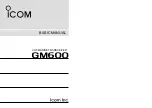
MFJ-1026 Instruction Manual
Deluxe Noise Canceling Signal Enhancer
2
Failure to use the external control line can result in slow transmitter power rise, or damage to the MFJ-
1026 components. This is especially true when a transmitter has fast envelope rise time, or has power
"overshoot" on the leading edge of the RF envelope. Some exciters overshoot to as much as 350 watts on
key closure before settling down to rated power.
Theory of Operation
It is commonly perceived that noise interacts with an antenna differently than a "desired" signal. Noise
that propagates over even short distances is an electromagnetic wave. Noise influences the antenna
exactly the same as desired signals. Noise also follows the same rules of propagation as the signals from
our transmitters. Noise does not have to be local in origin, it can also arrive by ionospheric propagation
from distant sources. This effect can allow noise from sources thousands of miles away to accumulate at
the receiving location and "mask" weak signals.
The MFJ-1026 allows you to create a "phased antenna system" out of nearly any pair of antennas. Since
noise and signals all behave the same way before the receiver, this fully adjustable phasing box can be
used to cancel or null unwanted signals, noise, or interference as well as enhance desired signals.
IMPORTANT:
The MFJ-1026 allows almost any combination of antennas to be used as a system, but the MFJ-1026
works best when the main and noise antennas have the same basic patterns when nulling or peaking
distance noise or signals. That means the antennas should be oriented in the same direction and also have
the same basic polarization for best performance.
It is not necessary to use any special length of feedline with the antennas, or for the antennas to be
"resonant" or physically large. Lower Q and smaller antennas often produce the most stable and reliable
performance. Failure to follow this basic guideline will often decrease performance when nulling or
peaking distant signals.
The MFJ-1026 has four primary advantages over typical phased antenna systems:
1. The user can electrically "rotate" the array, even though the antennas remain physically stationary.
2. The user can adjust both direction and wave angle of the null or peak.
3. The user can change from nulling a signal to peaking a signal with the push of a button.
4. Mutual coupling effects can be ignored as phase and level controls are adjusted.
When adding desired signals,
the noise and main antennas must both "hear" the desired signal. It is
preferable that both antennas be reasonably close together (within a wavelength) and of similar
polarization. Mixing a vertical antenna with a horizontal will almost always increase fading (contrary to
false rumors that it decreases fading) over an ionospheric path.

































